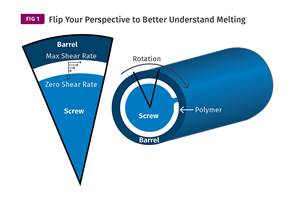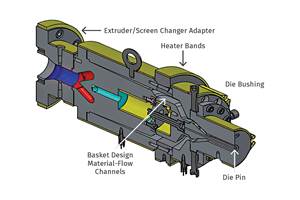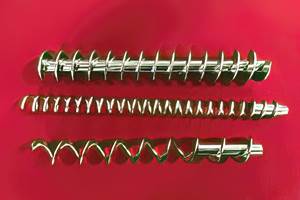Salt and Screw Cooling
Extrusion Know How
With both, watch how much you use.
Salt and screw cooling have something in common. A little improves the flavor but too much spoils the soup. The principle behind screw cooling is that by lowering the temperature of the screw the coefficient of friction between the polymer and the screw surface is reduced so the solids can slide on the screw.
This follows the traditional solids-feeding mechanism in which the polymer must stick to the barrel and slip on the screw, otherwise it will rotate with the screw and not move forward. In the case of polymers with low melting or softening points, such as EVA or polystyrene, screw cooling may be required for stable operation because of their tendency to stick to the screw at relatively low temperatures. This is also true of polymers that are typically preheated before being fed to the extruder.
So if a little cooling is good then it stands to reason that a lot is better, right? No. Excessive screw cooling can result in a skin of polymer building up on the screw root past where solids feeding has ended. This is not trivial, as it tends to reduce output and melting rate. In barrier screws, it also can restrict the flow in the melt channel, causing surging and reduced output and difficulty in purging. Moreover, it extracts energy from the early portion of the melting zone, where the purpose of the extruder is to add energy to the polymer.
During normal solids feeding in a single screw, the incoming polymer is typically at room temperature. It serves to cool the screw, keeping it below the melting or softening point of the polymer. When the screw is stopped with the barrel at operating temperature, this does not occur. Instead, heat from the discharge end of the screw is conducted back to the feed section until the screw temperature exceeds the melting or softening temperature of the polymer. This results in polymer sticking to the screw. Upon resumption of processing, the incoming polymer may not be able to dislodge the material stuck to the screw. This is commonly called a “screw collar.”
Most operators have encountered this situation and don’t want it to happen again; in many cases the screw has to be pulled and cleaned to completely resolve the problem. So operators tend to respond by using far more cooling than necessary. Some even believe this helps reduce the melt temperature.
When polymer is stuck to the screw in the solids-feeding area the screw will typically surge, output will be reduced, and air will often be entrapped in the extrudate. When these symptoms occur, the best fix is to feed chunks of polymer into the feed throat to try to dislodge the material. The size and amount of the chunks is proportional to the size of the screw, but in general use chunks as big as the screw can accommodate.
A 4.5-in. extruder, for example, might require a water bucket full of chunks to dislodge a collar. In many cases this works, but in severe cases the screw will have to be pulled and cleaned. Even small amounts of material stuck to the screw can be disruptive to processing.
The collar is usually not visible in the feed throat, as that is separately cooled. It most often forms just forward of the feed throat at the start of the barrel. New screws seem to have a greater propensity for collars when first installed; they have not built up a coating of waxes and other additives that reduce the tendency for polymer to bond to the screw.
The screw-cooling bore should stop at the end of the solids feeding zone. That location is a little hard to predict because all polymers melt differently depending on their thermal and frictional properties. Additionally, the onset of melting moves down the screw as speed increases. However, five diameters (5D) from the start of the flights is sufficient for most applications. In barrier screws (see illustration) the bore should stop well short of the barrier section. When it extends into the barrier section it can result in the problems noted.
As a rule of thumb, the water exiting the screw should be noticeably warmer than the water entering or you are using too much cooling water
Related Content
Understanding Melting in Single-Screw Extruders
You can better visualize the melting process by “flipping” the observation point so the barrel appears to be turning clockwise around a stationary screw.
Read MoreHow to Select the Right Tooling for Pipe Extrusion
In pipe extrusion, selecting or building a complementary set of tooling often poses challenges due to a range of qualitative factors. Here’s some guidance to help you out.
Read MoreWhat to Know About Your Materials When Choosing a Feeder
Feeder performance is crucial to operating extrusion and compounding lines. And consistent, reliable feeding depends in large part on selecting a feeder compatible with the materials and additives you intend to process. Follow these tips to analyze your feeder requirements.
Read MoreNPE2024 Wrap-Up: Sustainability Dominates Show Floor News
Across all process types, sustainability was a big theme at NPE2024. But there was plenty to see in automation and artificial intelligence as well.
Read MoreRead Next
People 4.0 – How to Get Buy-In from Your Staff for Industry 4.0 Systems
Implementing a production monitoring system as the foundation of a ‘smart factory’ is about integrating people with new technology as much as it is about integrating machines and computers. Here are tips from a company that has gone through the process.
Read MoreFor PLASTICS' CEO Seaholm, NPE to Shine Light on Sustainability Successes
With advocacy, communication and sustainability as three main pillars, Seaholm leads a trade association to NPE that ‘is more active today than we have ever been.’
Read MoreLead the Conversation, Change the Conversation
Coverage of single-use plastics can be both misleading and demoralizing. Here are 10 tips for changing the perception of the plastics industry at your company and in your community.
Read More.jpg;width=70;height=70;mode=crop)












